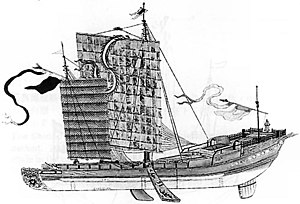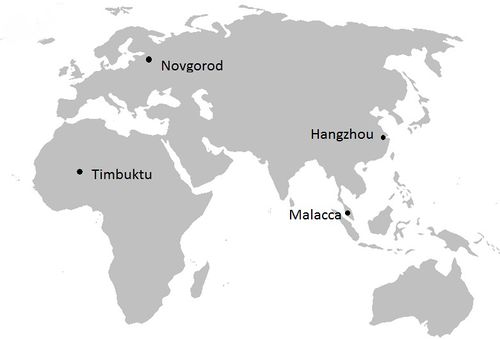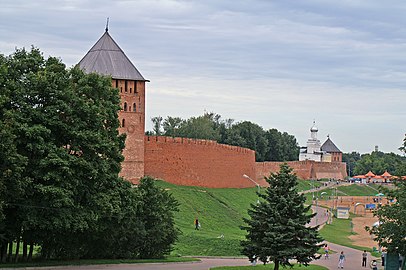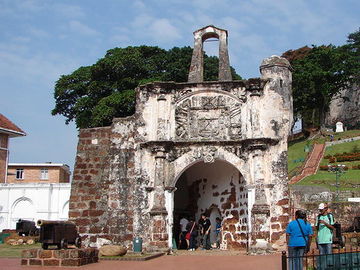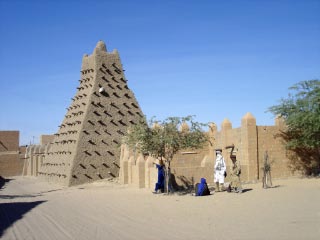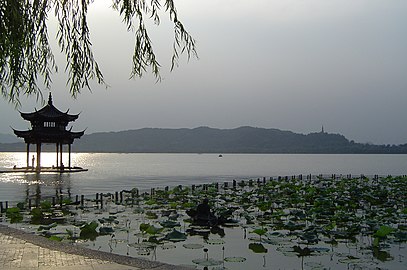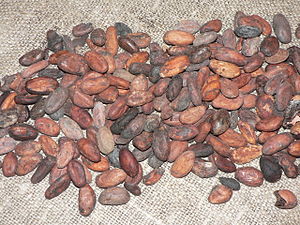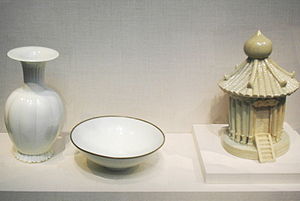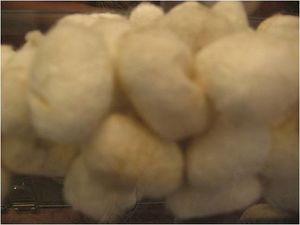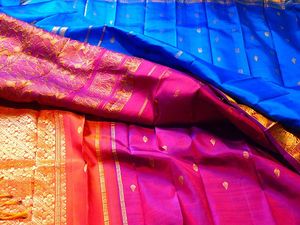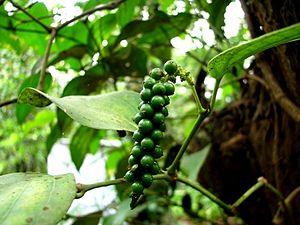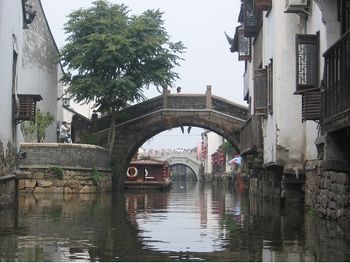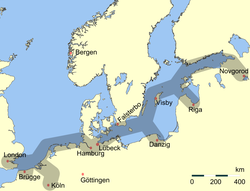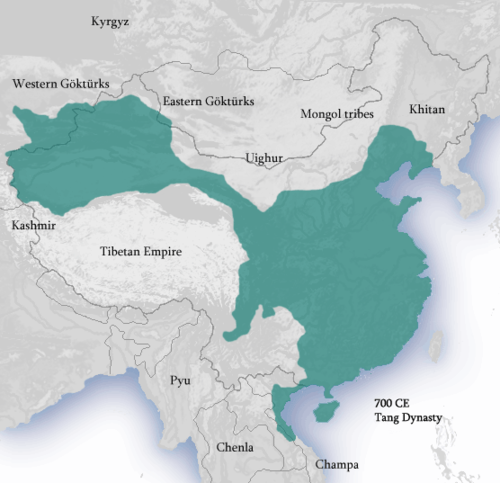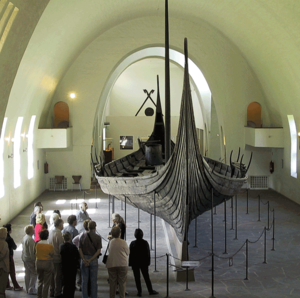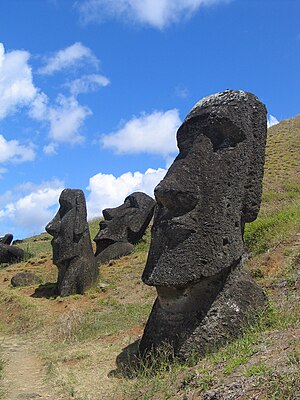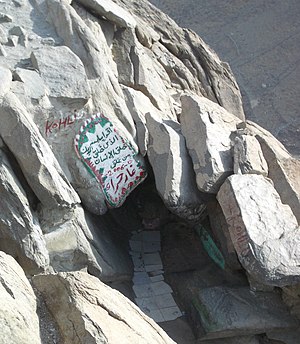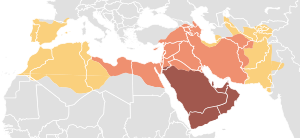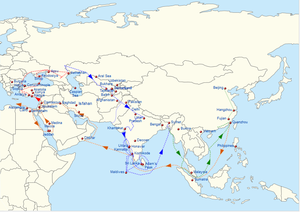Key Concept 3.1 Expansion and Intensification of Communication and Exchange Networks
"Although Afro-Eurasia and the Americas remained separate from one another, this era witnessed a deepening and widening of old and new networks of human interaction within and across regions. The results were unprecedented concentrations of wealth and the intensification of cross-cultural exchanges. Innovations in transportation, state policies, and mercantile practices contributed to the expansion and development of commercial networks, which in turn served as conduits for cultural, technological, and biological diffusion within and between various societies. Pastoral or nomadic groups played a key role in creating and sustaining these networks. Expanding networks fostered greater interregional borrowing, while at the same time sustaining regional diversity. The prophet Muhammad promoted Islam, a new major monotheistic religion at the start of this period. It spread quickly through practices of trade, warfare, and diffusion characteristic of this period." [1]
- I. Improved transportation technologies and commercial practices led to an increased volume of trade, and expanded the geographical range of existing and newly active trade networks.
- A. Existing trade routes continued into this period but all experienced significant changes, including the integration of growing commercial cities.
- A. Existing trade routes continued into this period but all experienced significant changes, including the integration of growing commercial cities.
- SILK ROAD NETWORK The Silk Roads continued to focus on luxury items such as silk and other items whose weight to value ratio was low. In the post-classical age, however, the Silk Roads diffused important technologies such as paper-making and gunpowder. Continuing a phenomenon from the classical age, they would also spread disease; the Black Death would spread from Asia to Western Europe along Silk Road and maritime routes eventually killing about one third of the people there. Despite these continuities, the Silk Road network would be transformed by cultural, technological and political developments. By 600 C.E., the classical empires of China, India and Rome had all crashed. Silk Road trade declined with them. The rise of the Islamic Abbasid Caliphate would invigorate trade along the Silk Roads once again. Sharia law, which gave protection to merchants, was established across the Dar al-Islam. Indian, Armenian, Christian and Jewish merchants alike took advantage of Muslim legal protection.[2] Courts and Islamic jurists called qadis presided over legal and trade disputes. All of this enabled trade by decreasing the risks associated with commerce. A more important boost to Silk Road trade in this era was the rise of the Mongol Empire. The Mongols defeated the Abbasid Caliphate in 1258 and the vast Pax Mongolica soon placed the majority of the Silk Roads under one administrative empire. Merchants were more likely to experience safe travel.[3] The Mongol code of law, known as the Yassa, imposed strict punishments on those disturbing trade.[4] The rule of the Mongols in central Asia coincided with the peak of Silk Road trade between 600 and 1450 C.E..
- MEDITERRANEAN NETWORK In the previous period (600 B.C.E. to 600 C.E.) the Mediterranean saw its heyday of trade under the territorial height of the Roman Empire. Like the Silk Road trade, this network declined when Rome weakened. However, the rapid spread of Islam across north Africa and the continuation of Roman civilization in the Byzantine Empire would revive trade in the post-classical age. As with all networks in this era, the religion of Islam had a positive impact on trade. Sharia law, the establishing of qadis and courts, along with the high regard with which Islam holds merchants (Muhammad was a merchant) all led to an increase of commercial activity where Islam had a significant presence. The Egyptian cities of Cairo and Alexandria, now under Muslim rule, became powerful commercial centers of the Mediterranean network. Muslim and Jews established trading firms in Cairo which benefited from the lucrative trade in silk yarn and cotton textiles.[5] Into the Mediterranean flowed precious gems and perfumes from India, along with the long standing trade items of olive oil and glassware. Constantinople, the capital of the Byzantine Empire, became an important hub of trade owing to its location between Europe and Asia. A major portion of the Silk Roads ended on the Black Sea, where goods would be loaded onto ships and carried through the Bosporus into the Mediterranean. The city's control of trade provoked the jealousy of the merchants of Venice, a powerful commercial city-state that thrived on the Italian peninsula at this time. Venetian merchants helped steer the Fourth Crusade toward Constantinople in order to gain a larger share of this trade.
- TRANS-SAHARAN NETWORK The Trans-Saharan trade routes that formed in the classical age grew enormously in the period from 600 to 1450 C.E. Here again, Islam played a primary role in this increase. During the Umayyad Caliphate Islam came to north Africa and reinvigorated trade. Caravan crossings of the Sahara desert increased the trade in gold, salt, ivory and slaves. Along these same routes, Islam spread to sub-Saharan portions of west Africa. For the first time, empires emerged under the Sarah desert, in large part because Islam brought the means to empower local kings and provide a point of unity. Mansa Musa's famous and extravagant pilgrimage to Mecca gave his kingdom of Mali wide recognition across the Dar al-Islam and served to increase trade connections across the Sahara.
- INDIAN OCEAN NETWORK Despite the growth of these important trade routes, Indian Ocean trade was the dominate network of trade in the post-classical period. In terms of the volume of trade, the number of people involved, and the interaction of various cultures, the Indian Ocean network was unrivaled in this period. It did, however, bears some continuities with the previous period (600 BCE to 600 CE). For example, it remained closely tied to environmental conditions, namely the monsoon winds that merchants had to consider while scheduling their departures. This meant that the port cities along the rim of the Indian Ocean at any given time had large numbers of non-citizens waiting for changes in the monsoon winds. Thus these cities were cosmopolitan and exuded a great deal of cultural tolerance. Because this is a maritime network, Indian Ocean trade continued to be the ideal network for exchanging bulk items, such as timber, ivory, spices, cotton textiles, and other things that would be difficult to move on land routes. Finally, Indian Ocean trade continued to be free from the domination of any state or empire. The seas were open to all merchants and not until the arrival of the Europeans would any single power attempt hegemony.
Indian Ocean trade also experienced major changes during the post-classical age. The volume of exchange increased dramatically and the number of civilizations participating increased. The coming of Islam played a significant role in the increase of trade in the Indian Ocean. We have seen already how the civilization of Islam encourages trade, and the Muslim city-states along the Swahili coast of east Africa contributed enormously to maritime trade. Gold, ivory, and exotic animals made their way from sub-Saharan and southern Africa to these cities, through which they entered the busy sea routes of the Indian Ocean. Islam followed the path of goods, making converts across the network, particularly southeast Asia. On the Malay peninsula in southeast Asia, the Buddhist kingdom of Srivijaya thrived on the lucrative spice trade that flowed through the straits of Malacca. Srivijaya became an important kingdom for the diffusion of Buddhism across the region. Another political development that increased Indian Ocean trade was the recovery and economic flourishing of China. During the Song Dynasty, Chinese maritime trade exceeded Silk Road trade, and Chinese porcelain has been found as far away as the Swahili coast of Africa.[6] The efficiency and volume of trade in the Indian Ocean was also facilitated by the introduction of new maritime technologies. The Chinese introduced the compass and massive trading ships called Junks which were able to carry larger cargoes. The Arabs popularized the Dhow ship which was able to tack against the wind because of its advanced lateen sail. Finally, an instrument called the astrolabe allowed skilled sailors to determine their latitude at sea. All of these advancements increased participation, facilitated navigation, and removed some of the risks of maritime trade.
The expansion and intensification of trade networks in the post-classical period led to the rise of new cities as major trade hubs. Cities became the collection points where craft items were massed for bulk sale, the crossroads of major trade routes, and the ports connecting zones of trade together. Some important examples are:
- As a member of the Hanseatic League, the northern Russian city of Novgorod was vital in connecting European merchants with their Arab and Byzantine counterparts. Its surrounding marshes and thick forests protected it from the Mongol conquests allowing its importance for the coveted trade in fine furs to be uninterrupted.
- In southeast Asia Malacca became an important city in the spice trade. It was a collection point for spices grown on tiny islands across Indonesia. In Malacca they were packaged and sold in bulk on the Indian Ocean. The city's location on the straits of Malacca allowed it to collect tolls and control passage.
- The location of Timbuktu on the southern rim of the Sahara Desert raised its importance for trans-Saharan caravan trade. It became an exchange point for west African gold and north African salt. Because of the trade in books, the city also became an important city for Islamic scholarship and education.
- Hangzhou was located near China's southern coast and on the Grand Canal which connected it across 1000 kilometers to Beijing. It was a departure point for Chinese goods to Korea, Japan, southeast Asia, and the Indian Ocean trade network. It became the capital of China during the Southern Song Dynasty.
- B. Althoughnot as extensive as the trade routes of Afro-Eurasia, Mesoamerica and the Andes regions developed extensive trade networks as well. These civilizations did not have the benefit of forming on major river systems as did the foundational civilizations in Egypt, the Middle East, and Asia. Some coastal trade did exist, but by and large the Aztec, Maya and Incas did not develop the sophisticated maritime trade of their counterparts on the other side of the globe. Nor did the civilizations in the Americas have the advantage of beasts of burden, except for the llama and alpaca of the Andes. Despite these limitations, Amerindians created an elaborate system of roads which they used for travel, trade, and to move their armies. The most sophisticated road system was constructed by the Inca and spans a total of 25,000 miles. It is clear that transregional trade occurred as well. Aztec merchants carried high value/low bulk items such as gems, exotic bird feathers and cacao across vast distances. Some of these items moved over 1200 miles. Mesoamericans traded these things with the Pueblos who lived in what is now New Mexico and Arizona in return for turquoise. When the Spanish arrived, they discovered that this distance was mediated by people who lived in the northern desert regions of Mexico. [8] As with most land-based long distance trade, items exchanged hands several times before they reached their destination. Although exchanges in Mesoamerica basically took place within a barter system, Aztecs sometimes used cacao beans (from which chocolate is made) as a form of currency. For example, if the value of goods being traded between two merchants was not precisely equal, one of them could make up the difference with cacao beans. [9]
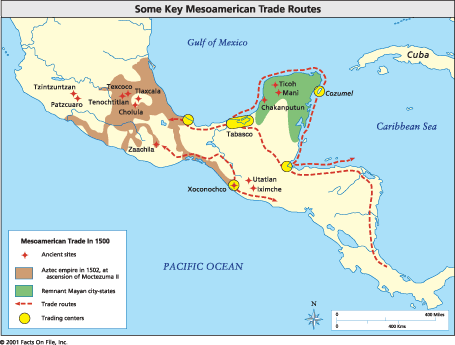 Map Source [7]
Map Source [7]
- B. Although
- C. During this period (600-1450 C.E.) interregional trade in luxury goods began to recover from its decline after the fall of Eurasian classical civilizations. Indeed, the exchange of luxury goods in the post-classical period surpassed that of the Roman/Han era. Luxury goods have important symbolic meanings in societies. As markers of status, they testify to expenditures arising out of surpluses far beyond necessity. [10] Manufactured primarily for external markets, luxury goods bear an association with all things exotic and foreign." [11] Most have rather mundane uses: silver plates and porcelain vases, silk clothing, and spices to enhance food. In these domestic settings luxury goods are "perceived as expressions of taste and civility."
- C. During this period (600-1450 C.E.) interregional trade in luxury goods began to recover from its decline after the fall of Eurasian classical civilizations. Indeed, the exchange of luxury goods in the post-classical period surpassed that of the Roman/Han era. Luxury goods have important symbolic meanings in societies. As markers of status, they testify to expenditures arising out of surpluses far beyond necessity. [10] Manufactured primarily for external markets, luxury goods bear an association with all things exotic and foreign." [11] Most have rather mundane uses: silver plates and porcelain vases, silk clothing, and spices to enhance food. In these domestic settings luxury goods are "perceived as expressions of taste and civility."
- The significant increase in luxury trade was the result of several factors. The creation of Mongol Khanates and the Islamic Caliphates along with the reconstitution of a powerful centralized state in China were certainly major factors. (The contributions of state formation to the revival in trade is explained in Key Concept 3.2.) In most areas, improved techniques of production, innovations in transportation, and new commercial practices impacted the surge in luxury goods during this period.
- The significant increase in luxury trade was the result of several factors. The creation of Mongol Khanates and the Islamic Caliphates along with the reconstitution of a powerful centralized state in China were certainly major factors. (The contributions of state formation to the revival in trade is explained in Key Concept 3.2.) In most areas, improved techniques of production, innovations in transportation, and new commercial practices impacted the surge in luxury goods during this period.
- During China's Tang Dynasty (618-907) the government standardized the production of porcelain which led to higher quality work and increased quantities. [12] They greatly perfected glazing techniques and mastered the process of regulating, with precise accuracy, the extremely high kiln temperatures necessary for the production of superior porcelain. [13] Production spread from northern China to the south as high quality kaolin clay was discovered there. Japan and Korea would copy Chinese silk production techniques, but no one could match the quality of Chinese porcelain in this period.
- During China's Tang Dynasty (618-907) the government standardized the production of porcelain which led to higher quality work and increased quantities. [12] They greatly perfected glazing techniques and mastered the process of regulating, with precise accuracy, the extremely high kiln temperatures necessary for the production of superior porcelain. [13] Production spread from northern China to the south as high quality kaolin clay was discovered there. Japan and Korea would copy Chinese silk production techniques, but no one could match the quality of Chinese porcelain in this period.
- One of the most coveted luxury goods in this period was silk. Although its methods would be duplicated and it would lose its exclusive monopoly of production, China's silk remained the standard of quality throughout this era. During the Sui and Tang dynasties, the state directly oversaw the production of silk and attempted to keep it a state secret. Tang emperors employed silk in the service of the state. They forbade the finest silk from being worn by anyone except the scholar bureaucrats in their administration. The color and pattern of the silk denoted rank and distinguished the bureaucrats from local aristocrats whose influence the government wanted to curb. Only the emperor and his family could wear yellow (for the Byzantines the royal color was purple.) [14] The quantity of silk produced in China, as well as in the Byzantine Empire and other states in Asia, increased tremendously. On the Silk Roads the precious fabric took on symbolic importance, especially in Buddhist monasteries whose interiors were draped with multi-colored silk tapestries donated by patrons. Silk became a de facto currency connecting otherwise disparate civilizations. Below are the basic steps of Chinese silk production:
- One of the most coveted luxury goods in this period was silk. Although its methods would be duplicated and it would lose its exclusive monopoly of production, China's silk remained the standard of quality throughout this era. During the Sui and Tang dynasties, the state directly oversaw the production of silk and attempted to keep it a state secret. Tang emperors employed silk in the service of the state. They forbade the finest silk from being worn by anyone except the scholar bureaucrats in their administration. The color and pattern of the silk denoted rank and distinguished the bureaucrats from local aristocrats whose influence the government wanted to curb. Only the emperor and his family could wear yellow (for the Byzantines the royal color was purple.) [14] The quantity of silk produced in China, as well as in the Byzantine Empire and other states in Asia, increased tremendously. On the Silk Roads the precious fabric took on symbolic importance, especially in Buddhist monasteries whose interiors were draped with multi-colored silk tapestries donated by patrons. Silk became a de facto currency connecting otherwise disparate civilizations. Below are the basic steps of Chinese silk production:
- Silk was not the only luxury good to travel along the roads bearing its name. Spices comprised an essential element of the trade in luxuries. In fact, the spice saffron actually had a higher value to weight ratio than silk.[15] But in the world of spices, black pepper was king. As early as Roman times, pepper from India had become a household possession of the rich. When the Visgoths threatened Rome in 410 one of the ransom items they demanded was 3000 pounds of pepper from India. [16] With the resurgence of large states and markets, the demand for pepper soared. Pepper helped food taste better, but it was also thought to have medicinal and preservative powers.
 A caravan making use of camel saddles. (Source: http://rolfgross.dreamhosters.com/ErmakovCollection/MyCollection.html)
A caravan making use of camel saddles. (Source: http://rolfgross.dreamhosters.com/ErmakovCollection/MyCollection.html)
- Silk
- Innovations in transportation networks also led to increased exchanges in luxury items. Caravan routes crossing central Asia underwent significant changes during this era that enhanced their performance and efficiency. The terrain between China and the western termini of the Silk Roads is some of the most inhospitable on the planet. Sparse water, extreme temperatures, deserts and rugged mountains made this crossing nearly impossible for individual travelers. Moreover, much of this territory was out of the control of most governments. Banditry was rampant. Thus merchants would only trade in lightweight high-profit luxury items that made the risks of the journey worthwhile. Only in caravans travelling familiar routes could a merchant or traveler hope to survive in this environment.
- Innovations in transportation networks also led to increased exchanges in luxury items. Caravan routes crossing central Asia underwent significant changes during this era that enhanced their performance and efficiency. The terrain between China and the western termini of the Silk Roads is some of the most inhospitable on the planet. Sparse water, extreme temperatures, deserts and rugged mountains made this crossing nearly impossible for individual travelers. Moreover, much of this territory was out of the control of most governments. Banditry was rampant. Thus merchants would only trade in lightweight high-profit luxury items that made the risks of the journey worthwhile. Only in caravans travelling familiar routes could a merchant or traveler hope to survive in this environment.
- As the caravan routes became standardized, nomadic people settled at frequent stopping points to offer services to merchants. For a fee, usually silk, they served as local guides or provided food, water and rest. This practice led to the development of fortified inns for weary travelers called caravanserai (from the Persia karavan sara, which means caravan palace). Some people of the Central Asia steppes made their entire livelihood this way, waiting for the next caravan to stop and get refreshed. With the expansion of luxury goods, caravanserai developed into large thriving centers which owed their very existence to caravan traffic. They also expanded their services. "Travelers would also often exchange their beasts of burden, to either obtain fresh, healthy, and rested animals or trade in one type of animal for another more suitable for the next stage of the journey." [17]
- As the caravan routes became standardized, nomadic people settled at frequent stopping points to offer services to merchants. For a fee, usually silk, they served as local guides or provided food, water and rest. This practice led to the development of fortified inns for weary travelers called caravanserai (from the Persia karavan sara, which means caravan palace). Some people of the Central Asia steppes made their entire livelihood this way, waiting for the next caravan to stop and get refreshed. With the expansion of luxury goods, caravanserai developed into large thriving centers which owed their very existence to caravan traffic. They also expanded their services. "Travelers would also often exchange their beasts of burden, to either obtain fresh, healthy, and rested animals or trade in one type of animal for another more suitable for the next stage of the journey." [17]
{{#invoke:Infobox|infobox}}
- Caravanserai, large and small, formed on the Silk Roads at intervals of about 100 miles, the average distance a camel could travel without needing water. [18] This indicates the important role the camel took on as a beast of burden in the harsh environment of Central Asia. Despite its remarkable adaptation to hot arid climates, the camel was useless for trade without a saddle. The humps on a camel's back are soft and non-supportive; one cannot simply throw packs of goods across its back. The "frame and mattress" saddle, probably developed by Arabs, distributed the weight of the cargo evenly across the camel's back allowing a single camel to carry 500 to 1000 pounds of goods. [19] The camel saddle, along with new breeding techniques (see infobox on Animal Husbandry), greatly increased the volume of luxury goods moving across Eurasia.
- Caravanserai, large and small, formed on the Silk Roads at intervals of about 100 miles, the average distance a camel could travel without needing water. [18] This indicates the important role the camel took on as a beast of burden in the harsh environment of Central Asia. Despite its remarkable adaptation to hot arid climates, the camel was useless for trade without a saddle. The humps on a camel's back are soft and non-supportive; one cannot simply throw packs of goods across its back. The "frame and mattress" saddle, probably developed by Arabs, distributed the weight of the cargo evenly across the camel's back allowing a single camel to carry 500 to 1000 pounds of goods. [19] The camel saddle, along with new breeding techniques (see infobox on Animal Husbandry), greatly increased the volume of luxury goods moving across Eurasia.
- Trade in luxury goods was also facilitated by innovations in forms of credit and economic exchange. Between 600 and 1450, China devised a relatively safe method to make large payments across a vast distance. Special documents, called "flying money," allowed merchants to pay for goods or taxes without having to transport coins in bulk. [20] From Arabs, the practice spread to Western Europe where Italian merchants advanced this method into bills of exchange. Merchants used bills of exchange to purchase imported goods without the hazards of carrying an expensive medium of exchange. The bills, which worked like modern checks, required the existence of two established networks, one of bankers and another of merchants. [21] A merchant would place his wealth in the safe keeping of a banking house which would in turn issue a bill of credit that could be used to purchase goods "imported from outside the local economy. The exporter of the goods would then present the bill for payment to his local representative of the banking network." [22] Of course, all of this had to take place within a framework of laws and courts to reduce the risks involved in such transactions.
- Trade in luxury goods was also facilitated by innovations in forms of credit and economic exchange. Between 600 and 1450, China devised a relatively safe method to make large payments across a vast distance. Special documents, called "flying money," allowed merchants to pay for goods or taxes without having to transport coins in bulk. [20] From Arabs, the practice spread to Western Europe where Italian merchants advanced this method into bills of exchange. Merchants used bills of exchange to purchase imported goods without the hazards of carrying an expensive medium of exchange. The bills, which worked like modern checks, required the existence of two established networks, one of bankers and another of merchants. [21] A merchant would place his wealth in the safe keeping of a banking house which would in turn issue a bill of credit that could be used to purchase goods "imported from outside the local economy. The exporter of the goods would then present the bill for payment to his local representative of the banking network." [22] Of course, all of this had to take place within a framework of laws and courts to reduce the risks involved in such transactions.
- D. It was to the benefit of a state to promote trade and one way they had a profound effect in doing so was the issuing of currency as a medium of exchange. The earliest form of trade was simple bilateral exchanges between two parties--ten chickens for one goat, for example. But this type of bartering slowed trade by limiting the number of possible connections between traders. What if the man with the goat did not have any need for chickens? For a transaction to take place, a person had to find someone who both needed what he had and had what he needed. Finding a medium of exchange--something that both parties desired, such as bolts of silk, precious metals or gems--allowed transactions to occur more frequently. The next logical step would be for a powerful state to issue an official medium of exchange, or currency, whose legitimacy they would back up. In China, the government issued tokens of brass or copper that could be used to buy most anything and could be taken as a form of payment. Now exchanges could occur between any two people who desired to buy or sell anything. But the amount of coins needed for large purchases could be bulky and dangerous to transport. The Chinese solved this problem by creating small pieces of paper with pictures of the coin printed on the front. The printing could indicate the value of a hundred or even thousands of coins. Paper currency was born.[23]
- D. It was to the benefit of a state to promote trade and one way they had a profound effect in doing so was the issuing of currency as a medium of exchange. The earliest form of trade was simple bilateral exchanges between two parties--ten chickens for one goat, for example. But this type of bartering slowed trade by limiting the number of possible connections between traders. What if the man with the goat did not have any need for chickens? For a transaction to take place, a person had to find someone who both needed what he had and had what he needed. Finding a medium of exchange--something that both parties desired, such as bolts of silk, precious metals or gems--allowed transactions to occur more frequently. The next logical step would be for a powerful state to issue an official medium of exchange, or currency, whose legitimacy they would back up. In China, the government issued tokens of brass or copper that could be used to buy most anything and could be taken as a form of payment. Now exchanges could occur between any two people who desired to buy or sell anything. But the amount of coins needed for large purchases could be bulky and dangerous to transport. The Chinese solved this problem by creating small pieces of paper with pictures of the coin printed on the front. The printing could indicate the value of a hundred or even thousands of coins. Paper currency was born.[23]
- States could also take on massive engineering projects to increase trade. One of the most important examples of this was the Grand Canal in China. Rivers are nature's highways and were the most effective means of getting goods from one place to another. China's major rivers, however, generally flowed west to east making it difficult to connect the populated area of the north to the rich agricultural areas of the south. Between 605-618, the Sui emperor Yangdi ordered the building of the Grand Canal. By connecting lakes and smaller canals already in place, it became possible for barges to transport to transport tons of grain from the Yangzi river region in the south all the way to the area of Beijing. The northern border, whose weakness had made the Han so vulnerable, was now able to have stronger fortifications. [24] Large granaries were built, one of which held 3.3 million bushels. [25] Additionally, the Sui Dynasty could project power in the southern region more readily, and benefited from taxing that fertile area. Overall, the Grand Canal allowed for the economic unification of China and would benefit China for one thousand years. However, the enormous strain on resources and labor weakened the Sui. Revolts against the emperor's rule culminated with the assassination of Yangdi and the end of the Sui dynasty. [26]
- States could also take on massive engineering projects to increase trade. One of the most important examples of this was the Grand Canal in China. Rivers are nature's highways and were the most effective means of getting goods from one place to another. China's major rivers, however, generally flowed west to east making it difficult to connect the populated area of the north to the rich agricultural areas of the south. Between 605-618, the Sui emperor Yangdi ordered the building of the Grand Canal. By connecting lakes and smaller canals already in place, it became possible for barges to transport to transport tons of grain from the Yangzi river region in the south all the way to the area of Beijing. The northern border, whose weakness had made the Han so vulnerable, was now able to have stronger fortifications. [24] Large granaries were built, one of which held 3.3 million bushels. [25] Additionally, the Sui Dynasty could project power in the southern region more readily, and benefited from taxing that fertile area. Overall, the Grand Canal allowed for the economic unification of China and would benefit China for one thousand years. However, the enormous strain on resources and labor weakened the Sui. Revolts against the emperor's rule culminated with the assassination of Yangdi and the end of the Sui dynasty. [26]
- As opposed to eastern Eurasia, where reorganized central states managed large commercial projects such as the Grand Canal, western Eurasia never reestablished centralized rule and consequently did not have the benefit of such broad state projects. However, individual cities took it upon themselves to form regional trade agreements. After western Europeans got a taste of Asian luxury goods during the Crusades, a vibrant Mediterranean trade began to flourish again. Unlike it's previous heyday under the Roman state, individual Italian city-states took the initiative managing the Mediterranean routes in the post-classical era. The most important of these city-states was Venice, which came to dominate the trade in luxury goods in the 14th century. [27] On the northern shore of Western Europe a more organized alliance of commercial cities formed called the Hanseatic League. It included cities from London to Novgorod Russia, and many in between along the North and Baltic Seas. The League was established to protect trade between member cities. It had is own court system to settle disputes and could summon military force to protect any of its members. Northern European trade focused on furs coming in from Russia, timbers from Sweden and Norway needed for ship building, and the bountiful fish pulled from the waters of the North Sea. [28]
- As opposed to eastern Eurasia, where reorganized central states managed large commercial projects such as the Grand Canal, western Eurasia never reestablished centralized rule and consequently did not have the benefit of such broad state projects. However, individual cities took it upon themselves to form regional trade agreements. After western Europeans got a taste of Asian luxury goods during the Crusades, a vibrant Mediterranean trade began to flourish again. Unlike it's previous heyday under the Roman state, individual Italian city-states took the initiative managing the Mediterranean routes in the post-classical era. The most important of these city-states was Venice, which came to dominate the trade in luxury goods in the 14th century. [27] On the northern shore of Western Europe a more organized alliance of commercial cities formed called the Hanseatic League. It included cities from London to Novgorod Russia, and many in between along the North and Baltic Seas. The League was established to protect trade between member cities. It had is own court system to settle disputes and could summon military force to protect any of its members. Northern European trade focused on furs coming in from Russia, timbers from Sweden and Norway needed for ship building, and the bountiful fish pulled from the waters of the North Sea. [28]
- E. As in the classical age, empires facilitated trade and brought large areas and new people under their economic management. These are great examples of the impact of state building on networks of communication and exchange.
- E. As in the classical age, empires facilitated trade and brought large areas and new people under their economic management. These are great examples of the impact of state building on networks of communication and exchange.
Empires and Trade 600-1450 CE
- China. In the 7th century, China's Tang emperor sent several military expeditions to the northwest. The purpose of these was to defend the border against nomads, particularly the Turks, but also to take control of much of the western trade routes. [29] This expansion (which was eventually stopped by the Abbasids at the Battle of Talas in 751) brought many ethnic groups into China's cities. These groups in turn provided commercial links to nomadic and settled people of their Central Asia homelands. As a result, Chang'an became intensely cosmopolitan. Serving as both the eastern terminus of the Silk Roads and the northern end of the Grand Canal, this city had large communities of non-Chinese ethnic groups who had settled there to take advantage of trade. By the 9th century, Uighurs dominated money lending, Sogdians ran the popular imported wine shops, and Turks were involved in the trade of many goods and Buddhist relics. [30]
- Byzantine. As with all empires, the expansion of the Byzantine empire broadened the groups of people participating in commerce. This began in the previous time period when Justinian temporarily conquered parts of northern Africa and Italy from the Vandals. Although these conquests were temporary, Byzantine trade connected Constantinople with commercial cities such as Alexandria and Tripoli as well as the islands of Crete and Sicily. When the Italian city-states emerged, they depended on imports of grain and textiles coming in from the Byzantine Empire. [31] The Empire also served as an important connection between Mediterranean trade and the Arab world. Another group of people pulled into the orbit of Byzantine trade was the state of Kievan Rus, or Russia. Kiev was an important mid point on the north/south trade routes connecting Constantinople to the fur traders of Novgorod and Scandinavia.
- Mongols. Having dissolved tribal loyalties and forged an unstoppable nomadic cavalry on the Central Asia steppes, Genghis Khan went on to conquer the largest land empire in history. The duration of the Mongol Empire was short compared to others, but never before or since has a single empire controlled the Eurasian land mass from China to Eastern Europe. When the conquests were done the entire length of the Silk Roads was in their domain and the Mongols settled down and enjoyed the benefits of trade. In an era known as the Pax Mongolica, or Peace of the Mongols, trade flourished under the protection of a flexible legal system and diplomatic protocols. They punished thieves and pirates. To extend commercial connections to Western European markets, the Mongols encouraged the building of port cities such as Kaffa on the Black Sea. They pushed trade outside of their empire by forcing Chinese to emigrate to South East Asia and form merchant communities in the trading ports there. In Cambodia, Vietnam, the Malay peninsula and Java, Chinese diaspora communities connected Mongol trade routes to foreign trading ports of the Indian Ocean network. [32]
- The Islamic Caliphates. Unlike some other belief systems, Islam has been pro-trade from the beginning (Mohammed was a merchant) and trade accounted in part for the rapid spread of the faith. Merchants traveled farther than armies and took their religion to remote areas of Eurasia. As new areas were incorporated into the Dar al Islam, its protective legal system and positive acceptance of merchants created welcome haven of exchange. Banks and credit emerged. Crops such as rice, wheat, eggplant and citrus were transplanted across Islamic civilization thus creating year-round cultivation in some areas. The trans-Saharan trade in salt took Islam to West Africa thus bringing the Sub-Saharan region into Afro-Eurasian networks. Seeking furs from northern Europe, Muslim merchants traveled to Russia and Scandinavia with silk and metal wares. The nature of the Indian Ocean trade it perfect for carrying bulk items such as spices, and Islam diffused to the Africa's Swahili Coast. In South East Asia, the port city of Malacca became an Islamic Sultanate around the year 1400 and remained so until the Portuguese showed up in 1511.
- II. The movement of peoples caused environmental and linguistic effects.
- A. As in the last era, technological adaptions to environmental conditions helped merchants expand and intensify trade. By minimizing geographical barriers to the flow of commerce, long-distance trade made greater connections across regions. You should have a solid knowledge of one of the following illustrations:
- A. As in the last era, technological adaptions to environmental conditions helped merchants expand and intensify trade. By minimizing geographical barriers to the flow of commerce, long-distance trade made greater connections across regions. You should have a solid knowledge of one of the following illustrations:
- In the 8th century, Scandinavians known as Vikings began to leave their home. The Viking practice of dividing land inheritances among all male heirs progressively diminished each family's holding of an already limited amount of arable land.[33] Consequently, they began to raid, pillage, and eventually settle elsewhere. The migrations of the Norsemen, as they were called, was made possible by a remarkable vessel, the Viking Longship. Its nearly forty foot wide sail could catch the North Sea's winds and drive it with great speed. In the absence of wind the boats could be propelled by oars. They were seaworthy enough for trans-Atlantic crossings but small enough to maneuver in shallow rivers. In the last half of the 9th century the Vikings crossed the North Sea, navigated the Seine River and sacked Paris 3 times. They burned it the third time, and pillaged Tours 7 times. [34]The Longship was light enough to be carried by its crew across a land-bridge and, unlike larger ships, could be run ashore thus alleviating the need for secondary landing crafts during a raid. [35] Despite their plundering and destroying, the movement of the Vikings had an impact on commerce. Their expansion connected several regional trading zones in Eurasia by linking Byzantine, Islamic, Northern European, and Central Asian routes via the Russians. The geographic reach given to the Vikings by their longships intensified trade. [36]
- In the 8th century, Scandinavians known as Vikings began to leave their home. The Viking practice of dividing land inheritances among all male heirs progressively diminished each family's holding of an already limited amount of arable land.[33] Consequently, they began to raid, pillage, and eventually settle elsewhere. The migrations of the Norsemen, as they were called, was made possible by a remarkable vessel, the Viking Longship. Its nearly forty foot wide sail could catch the North Sea's winds and drive it with great speed. In the absence of wind the boats could be propelled by oars. They were seaworthy enough for trans-Atlantic crossings but small enough to maneuver in shallow rivers. In the last half of the 9th century the Vikings crossed the North Sea, navigated the Seine River and sacked Paris 3 times. They burned it the third time, and pillaged Tours 7 times. [34]The Longship was light enough to be carried by its crew across a land-bridge and, unlike larger ships, could be run ashore thus alleviating the need for secondary landing crafts during a raid. [35] Despite their plundering and destroying, the movement of the Vikings had an impact on commerce. Their expansion connected several regional trading zones in Eurasia by linking Byzantine, Islamic, Northern European, and Central Asian routes via the Russians. The geographic reach given to the Vikings by their longships intensified trade. [36]
- Camels were well adapted tothe arid environments. In the heat of a desert, a camel's body will rise up to six degrees Fahrenheit to reduce the loss of water through perspiration. Additionally, the kidneys of a camel concentrate urine to extract as much water as possible. A camel can drink up to fifty gallons of water at a time and easily endure days--sometimes weeks--without water. [37] They have the capacity to close their nostrils, giving them protection from desert sandstorms. The Persians first introduced the camel to Egypt, but it did not thrive well in the fertile Nile valley. It was the Berber tribes of North Africa who made the most of this imported animal. Camels allowed the Berbers to organize regular caravan crossings of the Sahara Desert. These crossings had occurred for centuries but they were sporadic and periodic. Using camels and taking advantage of oasis stops, Berbers and Arabs created a systematic network for caravans across the Sahara. These ventures were not without risks. A few African tribes took control of key oases and charge exorbitant tolls, and strong sandstorms could still annihilate an entire caravan of merchants and camels. But gold from West Africa made the potential profits so high that merchants were willing to take the risks. With the added legal protection of Islamic law, Trans-Saharan flourished between 600 and 1450 C.E.. Evidence suggests suggests that by 1100 C.E. some caravans consisted in as many as twelve thousand camels. [38]
- Camels were well adapted to
- For the nomadic tribes of Central Asian the horse was the center of life. Much as been written already about the importance of the horse for the Mongol military, but there were economic benefits as well. Pastoral people found that a man on a horse could herd a group of animals much better than a man on foot. Horse flesh and milk were important parts of their diet and the hides of horses provided them with clothing and leather. Marco Polo reported that Mongol riders could stay on their horses for days without having to dismount for food. They could simply cut a vein on the horse's neck and sustain themselves by swallowing mouthfuls of its blood. [39] In terms of the intensification of trade networks, the horse's speed help get luxury goods across the vast open spaces of the Central Asia steppe lands. As a result, technologies, crops, religions and pathogens spread more rapidly across Eurasia.
- For the nomadic tribes of Central Asian the horse was the center of life. Much as been written already about the importance of the horse for the Mongol military, but there were economic benefits as well. Pastoral people found that a man on a horse could herd a group of animals much better than a man on foot. Horse flesh and milk were important parts of their diet and the hides of horses provided them with clothing and leather. Marco Polo reported that Mongol riders could stay on their horses for days without having to dismount for food. They could simply cut a vein on the horse's neck and sustain themselves by swallowing mouthfuls of its blood. [39] In terms of the intensification of trade networks, the horse's speed help get luxury goods across the vast open spaces of the Central Asia steppe lands. As a result, technologies, crops, religions and pathogens spread more rapidly across Eurasia.
- B. The movement of people had environmental effects. New tools and crops are carried on the backs of migrations and these can't help but alter man's relationship to the land.
- The migration of Bantu people across Africa, which was a protracted movement of people lasting about 2000 years, disseminated iron making technology across the continent. The effect on agriculture was profound. Sharp iron tools made reaping of crops much faster allowing more to be grown. Some parts of Sub-Saharan Africa experienced demographic changes. Making use of bananas, which were first brought to east Africa by Polynesian people, Bantu populations increased. [40] To meet the needs of growing populations, Bantu speaking people turned to irrigation and terracing techniques and experienced the associated environmental effects. Land was cleared and erosion took place at a greater rate. [41] Their use of cattle accelerated the land clearing. According to some historians, the pressures this put on resources led to the collapse of perhaps the most well known society of Bantu ancestory, Great Zimbabwe. In the absence of further technological innovations, the growing population exhausted the supply of firewood, soil, and pasture lands. [42]
- The migration of Bantu people across Africa, which was a protracted movement of people lasting about 2000 years, disseminated iron making technology across the continent. The effect on agriculture was profound. Sharp iron tools made reaping of crops much faster allowing more to be grown. Some parts of Sub-Saharan Africa experienced demographic changes. Making use of bananas, which were first brought to east Africa by Polynesian people, Bantu populations increased. [40] To meet the needs of growing populations, Bantu speaking people turned to irrigation and terracing techniques and experienced the associated environmental effects. Land was cleared and erosion took place at a greater rate. [41] Their use of cattle accelerated the land clearing. According to some historians, the pressures this put on resources led to the collapse of perhaps the most well known society of Bantu ancestory, Great Zimbabwe. In the absence of further technological innovations, the growing population exhausted the supply of firewood, soil, and pasture lands. [42]
- B. The movement of people had environmental effects. New tools and crops are carried on the backs of migrations and these can't help but alter man's relationship to the land.
- Another significant migration during this era was the movement of Polynesian people across the the Pacific Ocean. From their origins in East Asia, probably Taiwan, Polynesians spent several centuries “island hoping” to Fiji, Somoa, and Tahiti. By 500 C.E. they had reached the Hawaiian Islands. After learning to navigate with the stars and perfecting canoe building, their reach extended thousands of miles to complete the Polynesian Triangle, an imaginary triangle with Hawaii, New Zealand, and Easter Island forming its corners. (Hansen 127) Without a written language or the use of metals, they formed complex hierarchical societies. There is convincing evidence that Polynesian mariners travelled as far as the coast of South America. (P Manning) Nevertheless, these connected societies established in the Pacific remained largely isolated from the rest of the world.
- Another significant migration during this era was the movement of Polynesian people across the the Pacific Ocean. From their origins in East Asia, probably Taiwan, Polynesians spent several centuries “island hoping” to Fiji, Somoa, and Tahiti. By 500 C.E. they had reached the Hawaiian Islands. After learning to navigate with the stars and perfecting canoe building, their reach extended thousands of miles to complete the Polynesian Triangle, an imaginary triangle with Hawaii, New Zealand, and Easter Island forming its corners. (Hansen 127) Without a written language or the use of metals, they formed complex hierarchical societies. There is convincing evidence that Polynesian mariners travelled as far as the coast of South America. (P Manning) Nevertheless, these connected societies established in the Pacific remained largely isolated from the rest of the world.
- Animals taken by the migrating Polynesians had significant environmental consequences. In Hawaii the pigs they brought destroyed much of the indigenous flora and fauna. Much worse were the consequences of large edible rats the Polynesians carried to Easter Island. The pigs devoured the nuts and seeds from trees thus preventing them from replenishing. Probably to appease their gods, the Polynesians cut most all of the mature trees. Soon there was nothing left to make boats for fishing. After having eaten everything on the island they could, including their dogs, the population suffered a catastrophic collapse.
- Animals taken by the migrating Polynesians had significant environmental consequences. In Hawaii the pigs they brought destroyed much of the indigenous flora and fauna. Much worse were the consequences of large edible rats the Polynesians carried to Easter Island. The pigs devoured the nuts and seeds from trees thus preventing them from replenishing. Probably to appease their gods, the Polynesians cut most all of the mature trees. Soon there was nothing left to make boats for fishing. After having eaten everything on the island they could, including their dogs, the population suffered a catastrophic collapse.
- C. The movement of people in this era also led to the diffusion of languages. For example, the languages inside the Polynesian Triangle all developed from the base Polynesian language. The Hawaiian word kabu, which means "forbidden," is not much different for the Tahitian word for "prohibited," which is tabu. The word has made its way into English as taboo. [43] Likewise, the linguistic impact of the Bantu migration is evident in the fact that in Africa, both north and south of the equator, over 300 languages are spoken that belong to the Bantu linguistic family. [44] Many scholars believe that Swahili, the language of east Africa, is a blend of Bantu with Arabic. [45] This theory is plausible because of the large number of Islamic merchants in the Indian Ocean who traveled the monsoon winds to the eastern coast of Africa in search for trade and profit.
- C. The movement of people in this era also led to the diffusion of languages. For example, the languages inside the Polynesian Triangle all developed from the base Polynesian language. The Hawaiian word kabu, which means "forbidden," is not much different for the Tahitian word for "prohibited," which is tabu. The word has made its way into English as taboo. [43] Likewise, the linguistic impact of the Bantu migration is evident in the fact that in Africa, both north and south of the equator, over 300 languages are spoken that belong to the Bantu linguistic family. [44] Many scholars believe that Swahili, the language of east Africa, is a blend of Bantu with Arabic. [45] This theory is plausible because of the large number of Islamic merchants in the Indian Ocean who traveled the monsoon winds to the eastern coast of Africa in search for trade and profit.
- Arabic also spread during this time period, primarily as result of the rapid and extensive spread of Islam. Scholars desiring to study the Quran in its original language ensured Arabic instruction and diffusion. It was, along with Persian, one of the administrative languages of the Abbasid Dynasty. [46] As mentioned above, on the coast of East Africa it influenced Swahili. As Muslim merchants carried Islam to the Indonesian Islands, Arabic words entered the vocabularies of the local Malay languages. Where ever Islam spread, Arabic and Islam were "intertwined like body and soul." [47]
- Arabic also spread during this time period, primarily as result of the rapid and extensive spread of Islam. Scholars desiring to study the Quran in its original language ensured Arabic instruction and diffusion. It was, along with Persian, one of the administrative languages of the Abbasid Dynasty. [46] As mentioned above, on the coast of East Africa it influenced Swahili. As Muslim merchants carried Islam to the Indonesian Islands, Arabic words entered the vocabularies of the local Malay languages. Where ever Islam spread, Arabic and Islam were "intertwined like body and soul." [47]
- III. Cross-cultural exchanges were fostered by the intensification of existing, or the creation of new, networks of trade and communication.
- A. In the 7th century CE, the advent of a new major world religion would prove to connect other monotheistic faiths into a new network of trade and exchange, unprecedented in to scope and intensification.
- On the night of 17 Ramadan, Muhammad had the first of many apparitions that would transform world history. Overpowered by these visions, he began pouring forth the speech that would become the Quran (recitation). For two years he kept quite about his visions, only sharing them with his wife and her cousin, a Christian, both of whom thought these visions were from God. He began preaching openly in 612 and gained converts. Most of his preaching focused on the emerging economic inequalities around Mecca; it was wrong, he insisted, on building a private fortune rather than helping out the poor.
- The religion Muhammad started was called Islam, meaning surrender, because of their submission to God’s demand that human beings “behave to one another with justice, equity and compassion.” Such attitudes were to be expressed in the ritual prayers Muslims were required to make three times a day (later changed to five.) They were also required to give a portion of their wealth to the poor and to fast during the month of Ramadan, the month Muhammad had his vision. But above all the ritual and requirements, the purpose of Islam was to establish social justice on earth; their first duty was to build “a community characterized by practical compassion, in which there was a fair distribution of wealth. This was far more important than any doctrinal teaching about God.” [48]
- Islam did not develop in a cultural vacuum. It was strongly influenced by religions that had made their way into Arabia and by those it came in contact with as it spread. For example, the Persian religion of Zoroastrianism profoundly influenced Islam, primarily through the vehicles of Judaism and Christianity. Cross-cultural encounters between these religions and the Arabian Peninsula introduced the most prominent feature of Islam, its monotheism. Other influences on Islam were the ideas of an afterlife and final judgement, the belief in angels, a concept of the supernatural, and the embodiment of evil in the figure of Satan. Some scholars believe the concept of a linear history--as opposed to the cyclical view of repetition found in Asia--has its origin in early Zoroastrianism. [49]
- Most remarkable about Islam was its rapid spread from its place of origin into Byzantine provinces, North Africa, and even into Iberia (Spain). The armies of the Umayyad Caliphate took the Byzantine city of Damascus in 636 and Jerusalem two years later. In order to deprive the Byzantine Empire from a major source of grain and to secure a location for future conquests of North Africa, the Umayyads turned next to Egypt. Tripoli fell in 643 and all of North Africa within the next 75 years. [50]
- Compared to most religions in their original form, Islam began with a strong emphasis on trade. It helped that Muhammed and his wife were both involved in trade. Additionally, the yearly pilgrimage to Mecca provided occasions for merchants to make contacts and find trading partners. "So the hajj become not only a powerful factor in promoting religious unity and spreading Islam but it also materially assisted in strengthening the ties of commerce between Muslim lands and peoples, and between them and non-Muslim lands and peoples." [51] Through commercial connections, Islam spread from India to Indonesia; Muslim merchants took the faith to the Philippines. Trans-Saharan trade was the means by which Islam spread to Sub-Saharan Africa. Trade carried Islam and Islamic civilization returned the favor by encouraging and protecting trade.
- Military conquests and merchant activities were not the only ways Islam spread. Early in the history of Islam, a new order or “brotherhood” of Muslims emerged known as Sufis. Originally not a distinct sect (it existed in both Sunni and Shia forms of Islam) Sufism was more of a method for experiencing the divine. It placed mystical experiences of God over doctrinal purity. A prayer from one famous Sufi demonstrated this emphasis on divine union well: “Enter me, oh Lord, into the deep of the Ocean of Thine Infinite Oneness.” [52] Because Sufism did not stress specific creeds or beliefs, its mysticism had broad appeal in areas whose belief systems were traditionally animistic. It was Sufi missionaries who had the most success making converts among the Turks and in Sub-Saharan Africa. [53] Their missionary zeal and their message of peaceful Inclusivism make Sufism a major factor in the spread of Islam across Africa, Central Asia, South Asia, and Southeast Asia.
- B. Another example of cross-cultural exchanges during this time was the rise of diasporic merchant communities. The word “diaspora” comes from the Greek, meaning “to disperse.” Merchant diasporas were communities of people from a common culture living together outside their native homeland. They formed in ports, cities, and other important locations along major trade routes. Examples are communities of Jews living in Muslim Cairo, or an enclave of Muslim merchants living in Calicut on the coast of South Asia. The travel journals of Ibn Battuta and Marco Polo both mention the presence of Jewish merchant communities in China. [54] Diasporic communities provided convenient links to traveling merchants visiting foreign lands. For example, a merchant from South Asia traveling help bridge the cultural differences between the merchant and the host culture in which he was conducting business. "In an era when contracts could be hard to enforce, especially across political boundaries, it helped to deal with people who came from the same place you did." [55]
- The religion Muhammad started was called Islam, meaning surrender, because of their submission to God’s demand that human beings “behave to one another with justice, equity and compassion.” Such attitudes were to be expressed in the ritual prayers Muslims were required to make three times a day (later changed to five.) They were also required to give a portion of their wealth to the poor and to fast during the month of Ramadan, the month Muhammad had his vision. But above all the ritual and requirements, the purpose of Islam was to establish social justice on earth; their first duty was to build “a community characterized by practical compassion, in which there was a fair distribution of wealth. This was far more important than any doctrinal teaching about God.” [48]
- It was inevitable that culture from diasporic merchant enclaves would migrate into the host societies. When a Chinese merchant community settled in Nagasaki Japan, they recruited Buddhist monks from their homeland to join them. Buddhist rites were valued for trade and monks ensured a cultural consistency with the merchants' homeland. Next came the building of Buddhist monasteries and graveyards. Consequently, the growth of Chinese strands of Buddhism in Japan would have a long term impact on Japan. [56]
- It was inevitable that culture from diasporic merchant enclaves would migrate into the host societies. When a Chinese merchant community settled in Nagasaki Japan, they recruited Buddhist monks from their homeland to join them. Buddhist rites were valued for trade and monks ensured a cultural consistency with the merchants' homeland. Next came the building of Buddhist monasteries and graveyards. Consequently, the growth of Chinese strands of Buddhism in Japan would have a long term impact on Japan. [56]
- C. The journals of several famous travelers attest to the incredible integration of Eurasia trade routes in this era. Although their stories might not be accurate in every detail, the journals of a Muslim pilgrim, a Catholic merchant, and a Buddhist monk provide rich information about interregional networks of trade as well as the limitations people often have in understanding cultures much different than their own.
- C. The journals of several famous travelers attest to the incredible integration of Eurasia trade routes in this era. Although their stories might not be accurate in every detail, the journals of a Muslim pilgrim, a Catholic merchant, and a Buddhist monk provide rich information about interregional networks of trade as well as the limitations people often have in understanding cultures much different than their own.
- Ibn Battuta
- Ibn Battuta was born in Northwest Africa (present day Morocco) in 1304. At the age of 22 he departed for his haj to Mecca, a journey that would end up taking him much farther than he had planned. Seven years later he arrived in Delhi with an entourage of 40 companions, male and female slaves, over 1000 horses, crates of luxury items to give as gifts, and dozens of pack animals including camels. His total travels would take him 24 years and 75 thousand miles across the Islamic world.
- Ibn Battuta
- Battuta was able to travel this distance because of a network hostels and schools (masadras) across the Muslim world.
- D
- D
- IV. There was continued diffusion of crops and pathogens, including epidemic diseases like the bubonic plauge, throughout the Eastern Hemisphere along the trade routes.
References
- ↑ http://media.collegeboard.com/digitalServices/pdf/ap/ap-world-history-course-and-exam-description.pdf
- ↑ Worlds Together, Worlds Apart, (3rd ed., 2011), Robert Tignor, et al., p. 375.
- ↑ Before European Hegemony: The World System A.D. 1250-1350, (1989), Janet L. Abu-Lughod , p. 167,177.
- ↑ Genghis Khan and the Making of the Modern World. , (2004), Jack Weatherford, p. 67.
- ↑ Worlds Together, Worlds Apart, (3rd ed., 2011), Robert Tignor, et al., p. 366.
- ↑ The Song Dynasty in China. , Columbia University, Asia For Educators.(http://afe.easia.columbia.edu/song/out/trade.htm) .
- ↑ "Some Key Mesoamerican Trade Routes." Ancient and Medieval History Online. Facts On File, Inc. http://www.fofweb.com/activelink2.asp? ItemID=WE49&iPin=AK78&SingleRecord=True (accessed August 24, 2014)..
- ↑ "Trade Routes in the Americas Before Columbus." Academia.Edu https://www.academia.edu/4998969/Trade_Routes_in_the_Americas_Before_Columbus (accessed August 24, 2014).
- ↑ The History of Money, (1997), Jack Weatherford, p. 19.
- ↑ The Oxford Encyclopedia of Economic History, vol. 2, ed. Joel Mokyr, p. 401.
- ↑ Ibid.
- ↑ http://education.asianart.org/explore-resources/background-information/porcelain-tang-618%E2%80%93906-and-song-960%E2%80%931279-dynasties.
- ↑ China: A New Cultural History, (2013), Zhuoyun Xu.
- ↑ The Silk Roads: A History with Documents, (2012), Xinru Liu, pp. 23-24.
- ↑ Religions of the Silk Roads: Premodern Patterns of Globalization, (2010), Richard Foltz, p. 12.
- ↑ Premodern Trade in World History, (2008), Robert L. Smith, p. 92.
- ↑ Religions of the Silk Roads: Premodern Patterns of Globalization, (2010), Richard Foltz, p. 11.
- ↑ A Splendid Exchange: How Trade Shaped the World, (2008), William J. Bernstein, p. 58.
- ↑ Ibid, p. 56.
- ↑ History of the Weksel: Bill of Exchange and Promissory Note, Sergii Moshenskyi, (2008), p. 50.
- ↑ Credit and State Theories of Money: The Contributions of A. Mitchell Innes, (2004) L. Randall Wray, p. 197.
- ↑ Ibid.
- ↑ The History of Money, Jack Weatherford (1997), pp. 125-6.
- ↑ Encyclopedia of China: History and Culture, Dorothy Perkins (2013), pp. 188.
- ↑ China: A New History, John K. Fairbank, Merle Goldman (2006), pp. 78.
- ↑ Traditions and Encounters, Bentley, (2006), pp. 377-8.
- ↑ The Economy of Early Renaissance Europe, 1300-1460, Harry A. Miskimin, (1975), pp. 152-3.
- ↑ The Hanseatic Control Of Norwegian Commerce During The Late Middle Ages, John Allyne Gade, (1951), p. 108.
- ↑ China: A History, Harold Miles Tanner, (2009), p. 174.
- ↑ China's Cosmopolitan Empire, Mark Edward Lewis, (2012), p. 170.
- ↑ Economic Expansion in the Byzantine Empire, 900-1200', Alan Harvey, (2007), p. 223.
- ↑ Genghis Khan and the Making of the Modern World, Jack Weatherford, (2005), p. 224.
- ↑ The Fury of the Northmen: Saints, Shrines and Sea-Raiders in the Viking Age, John Marsden, (1993), p. 19.
- ↑ The Age of Faith, Will Durant, (1950), p. 474.
- ↑ The Fury of the Northmen, Marsden, (1993), p. 21.
- ↑ Encyclopedia of World Trade: From Ancient Times to the Present, Jerry Bentley, Patrick Manning, et al., (2015), p. 938.
- ↑ A Splendid Exchange, (2008), Bernstein, p. 55.
- ↑ A History of Sub-Saharan Africa, (2013), Robert O. Collins, James. M Burns, p. 231-2.
- ↑ http://afe.easia.columbia.edu/mongols/conquests/khans_horses.pdf
- ↑ Migrations in World History, (2005), Patrick Manning, p. 84.
- ↑ The Environment and World History, (2009), Edmund Burke, Kenneth Pomeranz, p. 219.
- ↑ The Environment and World History, Burke, p. 219.
- ↑ Voyages in World History, (2014), 2th ed., Valerie Hansen, p. 127-128.
- ↑ The Earth and Its Peoples, (2010), 5th ed., Richard W. Bulliet, p. 216.
- ↑ swahililanguage.stanford.edu/
- ↑ Voyages in World History, (2014), 2th ed., Valerie Hansen, p. 254.
- ↑ The Spread of Islam: The Contributing Factors, (2002), Abul-Fazl Ezzati, p. 363.
- ↑ Islam: A Short History, (2007), Karen Armstrong, p. 6.
- ↑ Iran and the Surrounding World: Interactions in Culture and Cultural Politics, (2011), ed Nikki R. Keddie, Rudi Matthee, p. 6.
- ↑ A History of Islamic Societies, (2014), Ira M. Lapidus, p. 49.
- ↑ "The Spread of Islam: The Contributing Factors, (2002), Abū al-Faz̤l ʻIzzatī, A. Ezzati,(2014), Ira M. Lapidus, p. 316.
- ↑ 'What is Sufism?, (1975),Martin Lings, p. 11.
- ↑ "The Spread of Islam, pp. 201-2.
- ↑ "Encyclopedia of Diasporas: Immigrant and Refugee Cultures Around the World. Volume I: Overviews and Topics; Volume II: Diaspora Communities, (2004), Melvin Ember, Carol R. Ember, Ian Skoggard, p. 153.
- ↑ "The World that Trade Created: Society, Culture, and the World Economy: 1400 to the Present, (2006), Kenneth Pomeranz and Steven Topik, p. 7.
- ↑ "Secondary Cities and Urban Networking in the Indian Ocean Realm, C. 1400-1800, (2008), Kenneth R. Hall (ed.), p. 208.



